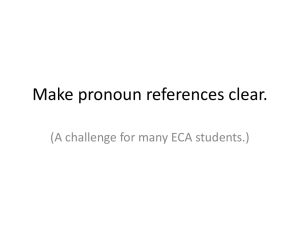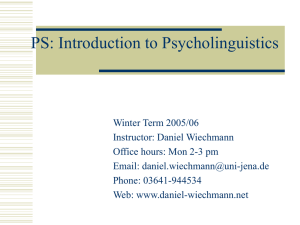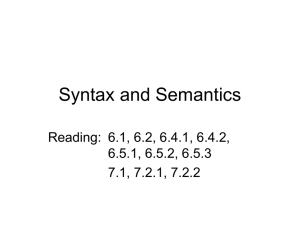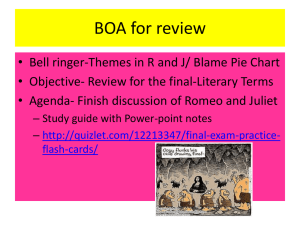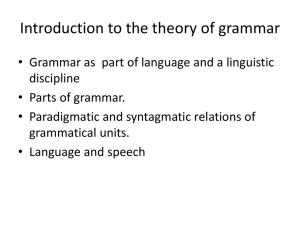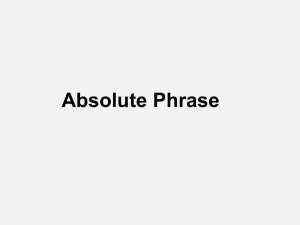Chapter 4: Syntax- The Sentence Patterns of Language
advertisement
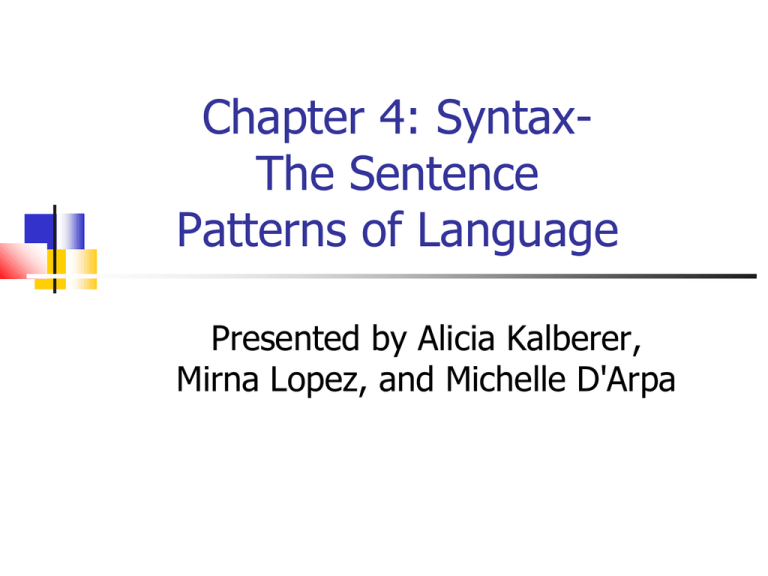
Chapter 4: SyntaxThe Sentence Patterns of Language Presented by Alicia Kalberer, Mirna Lopez, and Michelle D'Arpa WHAT IS SYNTAX? • The part of grammar that represents a speaker’s knowledge of sentences and their structure is called syntax. • Syntax specifies the correct word order for a language. • All languages have mechanisms like syntax to make a limitless number of sentences. • This is a characteristic shared by all speakers of a language. RULES OF SYNTAX • • Combines words into phrases and phrases into sentences. • Describes relationship between the meaning of a particular group of words and the arrangement of those words. • English is a Subject-Verb-Object [SVO] language. RULES OF SYNTAX (CONT.) Syntax also specifies the grammatical relationship of a sentence. Examples: subject and direct object Who is doing what to whom? Grammatical: Corresponds to syntactic structure for written communication. Ungrammatical: Does not correspond to the syntactic structure of written communication. RULES OF SYNTAX (CONT. 2) • Our knowledge of syntax tells us how words form groups in a sentence. • Syntactic rules reveal the grammatical relations among words of a sentences as well as the order of those words. SYNTAX ACTIVITY STRUCTURAL AMBIGUITY • Grammatically correct sentence that can be perceived with different meanings. STRUCTURAL AMBIGUITY (CONT. 2) Sherlock saw the man using binoculars saw Sherlock the man using binoculars DETECTING AMBIGUITY • Being able to perceive the dual meaning of homophones is the first skill that develops (Wankoff, 6). • The lady was annoyed by her in the doctor’s office. It was six o’clock and her appointment was at five. • Students would need to know the definitions of weight and wait in order to choose the correct word. AMBIGUOUS SENTENCES • Being able to detect both meanings of an ambiguous sentence is the skill that emerges next and indicates advanced reading skills (Wankoff, 7). • The waitress became upset when the glasses fell on the floor and broke. • Students would need to know the definitions of glasses in order to detect both interpretations of the sentence. Were the glasses for the thirsty customers or were they prescription glasses for the waitress to read the prices on the menu. CONSTITUENTS AND CONSTITUENCY TESTS A natural grouping or parts of a sentence are called constituents. There are three different tests mentioned in our textbook that help identify a constituent: Stand Alone Replacement by a Pronoun Move as a Unit STAND ALONE This constituent can stand alone. It can be used as the answer to a question. Example: I went to my room to look for my shoes. Where did you go to look for your shoes? My room. REPLACEMENT BY A PRONOUN This constituent can be substituted by a pronoun within the sentence. Example: Jonathan and Beth found the pencils on the desk. Jonathan and Beth found them on the desk. MOVE AS A UNIT This constituent can be moved, as a whole group, to another place in the sentence and it does not change the meaning. Example: It was a bone that the dog found in the dirt. The dog found a bone in the dirt. EXERCISE 12 Using one or more of the constituency tests discussed in this chapter, determine which of the boldfaced portions in the sentences are constituents. Provide the grammatical category of the constituents. A. MARTHA FOUND A LOVELY PILLOW FOR THE COUCH. • It can stand alone. (What did she find?) • It can be replaced by a pronoun. (it) If we moved it as a unit to another place it would change the grammatical structure. • • It is a noun phrase constituent. (NP) B. THE LIGHT IN THIS ROOM IS TERRIBLE. • It cannot stand alone. (What is terrible?) (It needs “the”) • It cannot be replaced by a pronoun. (This “it” is terrible?) • It cannot be moved. (If we move this chunk to another part of the sentence it becomes ambiguous.) • (Ungrammatical) If we are allowed to consider the C. I WONDER IF BONNIE HAS FINISHED PACKING HER BOOKS. • It can stand alone. (What do you wonder?) • It cannot be replaced by a pronoun. (I wonder (pronoun?).) • It can be moved if we add additional words. (Thus, if Bonnie has finished packing her books, we can leave now.) • It can be considered a noun phrase (NP) and a verb phrase (VP). D. MELISSA SLEPT IN HER CLASS. It can stand alone. (Where did Melissa sleep?) • • It can be replaced by a pronoun. (It can be replaced by “there”.) It can be moved and we can add a prepositional phrase. (In her class, Melissa slept on her desk.) E. PETE AND MAX ARE FIGHTING OVER THE BONE. • It can stand alone. (Who is fighting over the bone?) • It can be replaced by the pronoun “they”. • It can be moved and the sentence is transformed into a question. (Are Pete and Max fighting over the bone?) F. I GAVE A BONE TO PETE AND TO MAX YESTERDAY. • • It cannot stand alone. (It would an awkward answer to a question.) • It cannot be replaced with a pronoun. • If it is moved it yields an ungrammatical sentence. • It is not a constituent. ALTHOUGH, it could be a constituent under the “stand alone” test if words were allowed to be added to the phrase. (Did you G. I GAVE A BONE TO PETE AND TO MAX YESTERDAY. • It cannot stand alone. (It would an awkward answer to a question.) • It cannot be replaced with the pronoun. • If it is moved it yields an ungrammatical sentence. • It is not a constituent. LET'S SEE HOW WE DO WITH SOME EXAMPLES FROM GREAT BRITAIN. (THINK ABOUT ANY CLUES A CHILD MAY USE TO HELP THEM WIN THE GAME.) DISCUSSION QUESTIONS How does understanding syntax help the reader gather meaning from the sentence? Can teaching structural ambiguity be a good skill for young learners to help them learn a language? What is something new you have learned in this chapter that you might try to incorporate into the classroom? SYNTAX RESEARCH Cognitive Linguistic Approach for the basis of Language Acquisition • • • • • In order for any child or adult trying to learn a second language, they must acquire and internalize the syntactic rules of the language. The acquisition knowledge of syntax is acquired slowly as lexemes are learned. Different Linguistic Approaches argue the methodology of learning the language lexemes Analytical Linguistic Approach: Concerned with identifying, categorizing and describing the patterns found in language. Construction Approach: aim to account for the full range of facts about language, without assuming that a particular subset of the language is part of a privileged ‘core’. C IS FOR ... BBC © (2012) Kung- Fu Sentences [online game] RESOURCES http://www.bbc.co.uk/bitesize/ks1/literacy/making_sentences/play/ Fromkin, V., Rodman, R., and Hyams, N. (2011). An introduction to language (9th ed.). Heinle Goldberg, A.E. (1999) The Emergence of argument structure semantics.In The Emergence of Language (MacWhinney, B., ed.),pp. 197–212, Erlbaum Lamb, Sydney. M (1999) Cognitive Linguistic Pathway of the brain: The Neurocognitive Basis for Language/Philadelphia Spring Dance © PreTeena (May 4) Allison Barrows Wankoff, L., & Cairns, H. (2009). Why Ambiguity Detection Is a Predictor of Early Reading Skill. Communication Disorders Quarterly, 30(3), 183-192.

